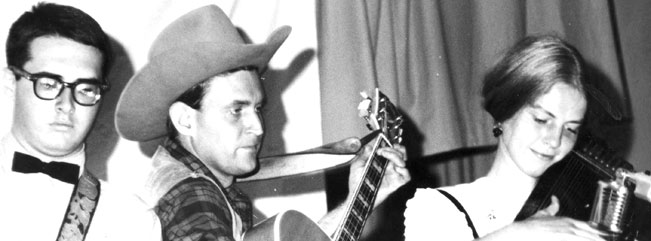
|
|
About Continuum Advertising Advisory Committee Archives Contact Us Continuum Home Faculty/Staff Subscribe related websites Alumni Association Marketing & Communications University of Utah Home |
 Back to Article
Back to Article
Urban PioneersFolk music revivalists of the Sixties reunite Revival: “To make live again”—to resuscitate, revitalize, and otherwise resurrect. When applied to music, revival is used to describe any form that is taken out of its original context and presented to a new audience. Just such a revival will happen in late January 2007, when a reunion of folk music revivalists takes place, produced by Carol Edison BA’73 MA’76 and Craig Miller MFA’85 of the Utah Arts Council’s Folk Arts Program. The event will include performances by a number of U of U alumni (and some not) who participated in the Sixties’ folk music scene: Brent Bradford BS’70, who still leads the bluegrass band The Stormy Mountain Boys; Hal Cannon BS’70, founder of the Western Folklife Center and cofounder of the Deseret String Band and the National Cowboy Poetry Gathering; Bruce W. Cummings BS’66, singer, guitarist, and original member of the Utah Valley Boys; Heather Stewart Dorrell MA’94 MEd’06, singer and guitarist; David K. Roylance BS’64 PhD’68, a banjo and guitar player who currently teaches engineering at MIT; and Polly Stewart BA’66, vocalist, autoharpist, and member of Polly & the Valley Boys (1964 to1966). Other participants will include Bruce “Utah” Phillips, an original member of the Utah Valley Boys and Polly & the Valley Boys (1964-66); well-known folksinger/songwriter Rosalie Sorrels; and singer-scholar of Native American folklore Barre Toelken, who once taught in the U of U English department (1964-1966) and has spent the last 20-some years teaching folklore in the English department at Utah State University. Phillips and Sorrels were the first folksinger revivalists in the Intermountain region and are credited with initiating the movement in Utah. The folk music revival reached its height nationally between 1957 and 1968—a time when the U.S. was involved in an increasingly unpopular war, the civil rights movement was in full swing, and young adults were gathering in coffee houses around the country in search of their roots, bringing to life the music of a simpler, quieter time. Folk music is what it says it is: a creative form that comes directly from the people. Folk songs speak of the trials and tribulations of daily life, of family ties broken and mended, of loves gained and lost, of sunsets and seasons, births and deaths. In essence, folk music touches every aspect of human existence. But in 1968—the year of the Robert Kennedy and Martin Luther King Jr. assassinations, the Tet offensive, and the Democratic National Convention riots in Chicago, among other momentous events—the wind was taken out of the movement’s sails and it disappeared under the radar. Stewart, a recently retired professor of English at Salisbury State University in Maryland, is helping organize this one-time “reunion of the geezers” performance, as she calls it, which will take place Jan. 24, 2007, at Highland High School in Salt Lake City (2166 S. 1700 East) at 7:30 p.m. For tickets, go to www.iamaweb.org and click on “Events.” Tickets will also be sold at the door. A follow-up article will appear in the Fall 2007 issue of Continuum. |
